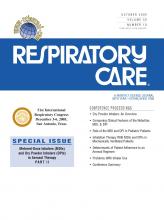Abstract
Topically inhaled bronchodilators and corticosteroids are the mainstay of treatment for asthma and chronic obstructive pulmonary disease. These medications are delivered via jet or ultrasonic nebulizer, metered-dose inhaler (MDI), or dry powder inhaler (DPI). While the number of devices may be confusing to patients and clinicians, each device has distinct advantages and disadvantages. Most clinical evidence shows that any of these devices will work for most situations, including exacerbations and in the stable outpatient setting. There is a high rate of errors in device use with all these devices, especially the MDI. In choosing a drug/device combination for a patient, the clinician must take into account several factors, including the cognitive and physical ability of the patient, ease of use, convenience, costs, and patient preferences. Clinicians should also have a rudimentary understanding of aerosol principles in order to be able to teach appropriate use of aerosol devices to their patients.
- aerosol
- asthma
- bronchodilator
- corticosteroids
- chronic obstructive pulmonary disease
- COPD
- dry powder inhaler
- DPI
- metered-dose inhaler
- MDI
- nebulizer
- drug delivery
Footnotes
- Correspondence: David E Geller MD, The Nemours Children's Clinic, 83WColumbia Street, Orlando FL 32806. E-mail: dgeller{at}nemours.org.
- Copyright © 2005 by Daedalus Enterprises Inc.











